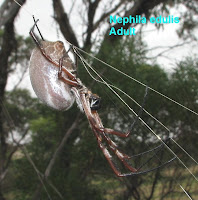

Golden Orb-weaving Spider - Nephila edulis
These Golden Orb Spiders are large, with a north Queensland one being the biggest Australian species, growing to 45 mm (nearly 2") in body length. Our local one is around 25 mm (1"), although with legs included it would span about 90 mm (nearly 4"), so still a respectable size. Males are very much smaller with a body length of approximately 5 mm (1/4") and do not make a web, but inhabit the female's, as will other small arachnid species. These smaller spiders feed on the insects that are to small for the large web owner, but this relationship is also of benefit to the female as the web is kept clean with the risk of disease reduced.
Their golden coloured webs are extremely strong and those that have been constructed over time, have numerous cable like threads consisting of two or more normal threads that span across each side of their orb web. These are very strong and with other parts of the web, will hold securely the very large Wood Moths and even small birds. However these webs often have bits of debris in them and commonly appear very tangled and untidy.
An interesting observation concerning the local Nephila edulis spider, is they are quite common in coastal alkaline areas, but are seldom found in neighbouring acid sandy heathland. This is quite pronounced as I have encountered them on the boundary where these different soil types abut and further into the alkaline zone, but none the other way. At a guess, it is possible that the vegetation in alkaline areas is more suitable for their web structure. They need a reasonably open location (usually more windy) and sturdy vegetation to anchor their heavy-duty webs. In the sandy (acid) heath zones, the vegetation species are more mixed and generally lighter in structure, meaning they move more in strong winds. This extra movement may stretch the less flexible multi-threaded cables to make them less functional.
Update: 30 March 2009Photos of males, juvenile females and egg-sac have been added along with the species name ie, Nephila edulis.
The vegetation type I believe is an important factor as to where this spider is found (see remarks above). This species does occur in acid sandy heath regions, but only where study vegetation is available to anchor their webs and not have them damaged by excessive movement during windy weather, which is likely if attached to lightly structured shrubs that are typical of heathland regions. In an open woodland (not common to the immediate Esperance area), they were found to be very common with huge webs to 3 metres (10") off the ground and all attached to strong eucalypt branches or study shrubs below. In one web I came across an adult female was sharing with three juvenile females that were about two thirds her size, plus a couple of tiny males of around 5 mm (under 1/4") in body length.






